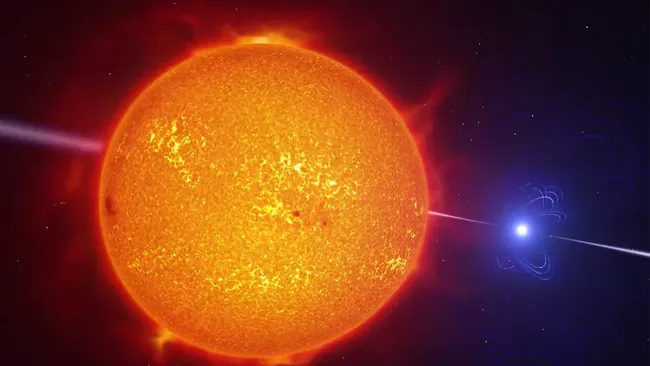Astrophysics never ceases to surprise us, and the recent discovery of a peculiar and record-breaking energy burst from a binary star system has sparked new questions about the universe’s hidden mechanisms. This phenomenon, designated GLEAM-X J0704-37, challenges conventional wisdom about stellar systems and energy production. By delving into this fascinating topic, we uncover not only the mystery behind this rare event but also what it tells us about the broader cosmos.
What Are Long-Period Radio Transients?
Long-period radio transients are rare astronomical phenomena involving periodic radio wave emissions from celestial sources. Unlike the fast bursts seen in pulsars or supernovae, these signals occur over long intervals, often spanning hours, and last for several seconds to minutes. First detected in 2006, their exact origins have puzzled scientists for nearly two decades.
The case of GLEAM-X J0704-37 adds a new layer to this mystery. This energy burst, occurring at three-hour intervals and lasting up to a minute, is the longest-period transient discovered so far. Its location at the edge of the Milky Way—a relatively sparse region—offers an unparalleled opportunity to isolate its source and study its nature.
The Discovery of GLEAM-X J0704-37
In archival data from the Murchison Widefield Array (MWA), astronomers identified strange, bright radio pulses emanating from a source 5,000 light-years away. Designated GLEAM-X J0704-37, these pulses had a peculiar periodicity, sparking intrigue within the scientific community.
Unlike previously studied transients, GLEAM-X J0704-37’s sparse surroundings provided a clearer observational field. This enabled researchers to narrow down the source, eventually pinpointing it using the MeerKAT telescope in South Africa. The discovery was groundbreaking not only for its unusual periodicity but also because it marked the longest-duration radio transient yet observed.
The Binary System Behind the Burst
At the heart of the mystery lies a binary star system containing a low-mass red dwarf and a white dwarf—the dense stellar core left behind after a star exhausts its nuclear fuel. This pairing is not unique in the universe, but the energy bursts originating from this system certainly are.
Red dwarfs are small, cool stars known for their longevity and stability, while white dwarfs are dense remnants of stars that have shed their outer layers. Together, they form a dynamic system where gravitational interactions and magnetic activity can lead to unusual phenomena. In this case, the interaction between the two celestial bodies is believed to be the source of the enigmatic energy bursts.
What’s Causing the Energy Bursts?
Scientists propose that the radio bursts are caused by intense magnetic activity within the binary system. The red dwarf’s magnetic field, influenced by the white dwarf’s gravitational pull, likely generates powerful currents. These currents interact with the surrounding material, producing the observed radio emissions.
The unique M-shaped spectral pattern observed in the bursts adds another layer of complexity. This pattern, recurring every three hours, suggests a dynamic interplay between the two stars and their environment. The system’s behavior points to a magnetic reconnection event—a process where magnetic field lines snap and realign, releasing vast amounts of energy.
Why Is This Discovery Important?
The study of GLEAM-X J0704-37 sheds light on previously uncharted territory in astrophysics. Understanding the mechanics of long-period radio transients can:
- Advance Stellar Evolution Models: The interaction between the red dwarf and white dwarf provides new insights into binary star systems, refining existing models of stellar evolution.
- Enhance Knowledge of Magnetic Fields: Magnetic reconnection events, as observed in this system, are key to understanding not only stellar physics but also phenomena like solar flares on our Sun.
- Broaden Cosmic Perspectives: By exploring such unique systems, scientists can better grasp the diversity and complexity of the universe’s mechanisms.
What Sets GLEAM-X J0704-37 Apart?
Unlike other transients, GLEAM-X J0704-37’s bursts occur in a sparsely populated region of the Milky Way, making it easier to isolate and study. Additionally, its binary nature—a red dwarf paired with a white dwarf—differs from the typical sources of long-period transients.
This system challenges prior assumptions about energy bursts in binary systems. The involvement of a red dwarf, rather than the more commonly implicated neutron stars or black holes, marks a departure from established norms. Furthermore, the three-hour periodicity and M-shaped spectral pattern add layers of complexity to the mystery.
The Broader Mystery of Long-Period Transients
While GLEAM-X J0704-37 offers valuable clues, it also raises new questions. How common are such systems? What other mechanisms might generate similar energy bursts? And what do these phenomena tell us about the underlying physics of the universe?
Addressing these questions will require a combination of observational and theoretical approaches. By studying more examples of long-period transients, scientists can identify patterns and refine their understanding of these enigmatic phenomena.
What’s Next for Astronomers?
The discovery of GLEAM-X J0704-37 opens the door to further exploration of long-period radio transients. Future research will focus on:
- Detecting Similar Systems: Using advanced telescopes to search for other transients with similar characteristics.
- Modeling Magnetic Interactions: Developing detailed simulations of magnetic reconnection events in binary systems.
- Exploring the Edges of the Milky Way: Conducting targeted surveys of sparsely populated regions to uncover hidden phenomena.
Conclusion
The record-breaking energy burst from GLEAM-X J0704-37 is more than just a cosmic curiosity—it’s a window into the universe’s most fundamental processes. By unraveling the mystery of this binary system, scientists are not only solving a 20-year-old puzzle but also expanding our understanding of the cosmos.
Reference:



















